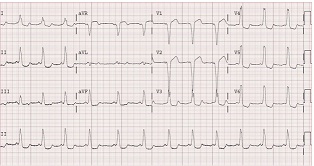Inquiry Problem :
Using information from the class and lab, and the case study below, prepare an exercise test manual/document that includes:
1. Preparticipation screening algorithm (you will be asked to determine the appropriate course of action for a case study on the final practical exam) as well as the need for clinical exercise testing.
2. Pre-, during-, and post-test procedures to include patient set-up, data collection, safety precautions in each of these phases.
3. Test termination criteria (for both normal and abnormal/positive tests; expect the unexpected during your final practical exam).
4. Test interpretation (for all data collected such as HR, BP, exercise capacity, etc.) whether normal or abnormal responses to exercise testing.
5. Prognosis using the Duke Scale (determination of angina level, ST segment deviation from the J-point, max MET level achieved converted from VO2max).
6. Final recommendations following results of exercise testing (e.g., safe to begin exercise, further diagnostic testing/medical clearance recommended, etc.).
Your group will be able to use this manual/document during the final practical exam so be thorough in your preparation of this assignment. Organize your document and all procedures/information should follow current ACSM recommendations (10th Edition Guidelines). Consider a table of contents with written explanation for each included component. In addition and as practice for the final exam, include in your manual a case study that assumes the following results for a clinical exercise test on a 68 year old male (using the standard Bruce Protocol):
|
HR (bpm) = 115 (1 min.), 120 (2 min.), 127 (3 min.), 137 (4 min.), 142 (5 min.), 149 (6 min.)
|
|
HRR (bpm) = 150 at 1 min., 142 at 2 min. (supine rest recovery)
|
|
BP (mmHg) = 150/90 (stage 1), 193/91 (stage 2)
|
|
RPE = 15 (end of stage 1), 19 (end of stage 2)
|
|
S/S = profuse sweating (stage 2), mild ataxia (stage 2), moderate "2" dyspnea (stage 2)
|
|
Angina scale = moderate "2" angina (stage 2)
|
|
Test terminated = volitional fatigue end of stage 2
|
|
EKG = ST segment change stage 2 (see figure below to determine degree of change) - use any lead V3-V6
|
|
Gas Exchange = N/O, predict VO2max and max MET level from ACSM metabolic equation (see page 152 in ACSM Guidelines 10th Ed.)
|

ST segment abnormality during stage 2 of clinical GXT (note in leads V3-V6) to be used for test interpretation.
Interpret the results of the test (EKG for ST segment only, cardiorespiratory, and hemodynamic responses). Indicate for the following variables whether each result was a normal or abnormal response based on established criteria:
• HR, HRR (recovery), BP, RPP, symptoms, exercise capacity (including percentile ranking)
• Determine the significance of ST segment deviation using the above tracing
Determine the prognosis (5 yr. survival and avg. annual mortality rate) using the Duke Scale . Would you recommend that this person begin an exercise program at this point? Why or why not? What other recommendations would you offer regarding further diagnostic testing?